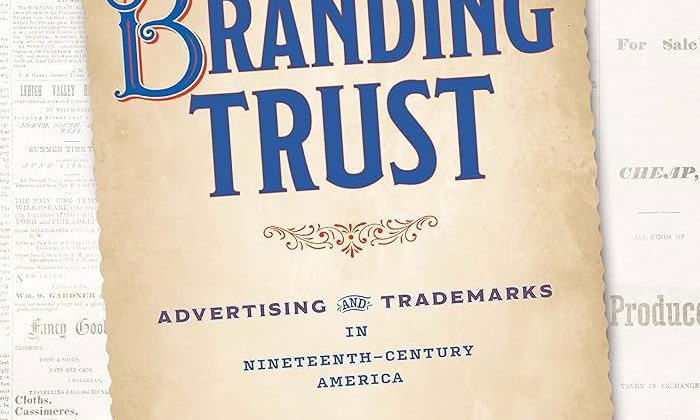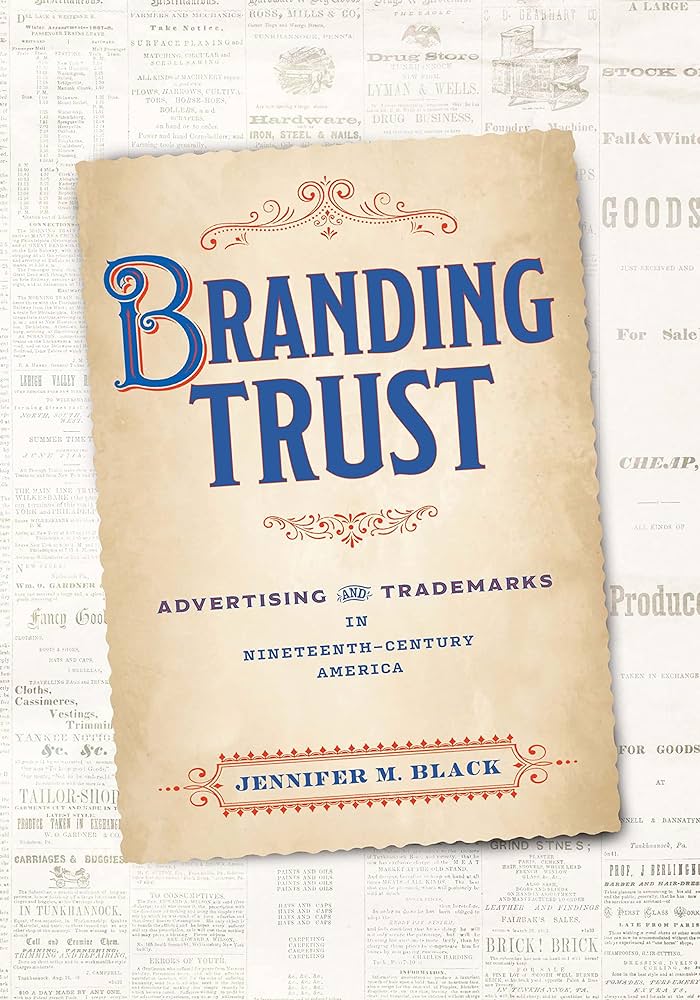

Jennifer M. Black is Associate Professor and Program Director of History at Misericordia University. This interview is based on her new book, Branding Trust: Advertising and Trademarks in Nineteenth-Century America (University of Pennsylvania Press, 2023).
JF: What led you to write Branding Trust?
JB: This project grew out of a seminar paper I wrote when I was a graduate student at the University of Southern California, taking a class on the History of the Book. I was fortunate to have two wonderful professors in that class—Deb Harkness and Daniela Bleichmar—who were very encouraging. There was only one problem: at that point, I was studying mid-twentieth century advertising and the film industry, and for the class, I had to write a paper on a topic before 1900. Harkness encouraged me to look at the ephemera collections at the Huntington Library, where I met and subsequently worked closely with their new graphic arts curator. That is where I found advertising trade cards: the hand-held, colorful objects were so weird and interesting to me that I spent the next several years looking at as many trade cards as I could access. That early research eventually ballooned to include over 5,000 objects, which formed the basis for two articles and the fourth chapter of my book. My obsession with trade cards eventually led me to research almanacs, posters, and other visual media, to try to understand how trade cards fit into the history of graphic design. There seemed to be so much symbolism underlying the quaint and quirky images I found on trade cards, and I wanted to know more about how advertising professionals conceived of the objects to achieve their goal of generating more sales. That question eventually led me to investigate business treatises and guidebooks, trademark theory and use, the concept of goodwill, and litigation to punish unethical business practice.
JF: In 2 sentences, what is the argument of Branding Trust?
JB: After 1830, printers, entrepreneurs, and advertising professionals devised visual and textual strategies that would appeal to consumers, gain their trust, and solidify brand identity. This visual language of trust—symbolized in the trademark—grew out of middle-class ideas and has come to define both American consumer culture and trademark law.
JF: Why do we need to read Branding Trust?
JB: I think that a lot of readers may be surprised to learn that branding, as a practice, has a deep history that evolved slowly and incrementally over time. Though the 1920s has often been held up as the birth of “modern” advertising, advertising professionals actually honed and refined their practice over the previous century. Multiple actors—including printers, entrepreneurs, advertising professionals, merchants, and even the public—collaborated in a feedback loop that saw pockets of innovation sporadically appear throughout the nineteenth century. Some strategies worked, but many didn’t; the process of figuring out how to effectively brand and market a product that would gain consumers’ trust (and procure sales) was a gradual and uneven one.
There are so many interesting (and surprising!) components to this story. For example, graphic design innovations first came from newspapers and printing professionals in rural communities in the 1840s—not, as one might expect, in New York City (in fact, newspapers in NYC were behind the curve in terms of advertising innovations for much of the nineteenth century). Entertainment aesthetics figured into advertising practice early on, as well; from the colonial period printers and others looked for ways to make the ads they created entertaining, humorous, and visually attractive in order to draw in potential consumers. Professional advertising agents emerged in the early 1840s, offering comprehensive services that prefigured the “modern” agencies of the early twentieth century. At the same time, entrepreneurs worried about unfair competition and trademark infringement, which could potentially cut into profits and harm their reputations. Trademark regulation emerged first from the problem of fraud in the market (not from top-down legislative actions), and was intrinsically shaped by the judges hearing the first trademark lawsuits in court.
JF: Why and when did you become an American historian?
JB: I sort of fell into it, I guess. Looking back, it makes perfect sense to me now that I ended up where I am, studying what I do, but I certainly didn’t have that kind of direction when I was trying to figure it all out. I started college as a musical theater performance major, and ultimately finished with a BA in art history. I had taken a course on Asian art history that focused on the religious iconography of India and East Asia, and I found the structured symbolism of Buddhist and Hindu sculptures fascinating. That was the beginning of my fascination with images and their symbolism. Though I went on to finish a master’s degree in public history, I ultimately decided to pursue a PhD in American history with a concentration in visual studies because I wanted to be able to write and teach about images in history. I had recently read Vanessa Schwartz’s book, Spectacular Realities, which discussed how nineteenth-century Parisians visited the morgue on the weekend for entertainment, to see the tableau-style recreations of death scenes (which the morgue crafted to solicit identifications of the unclaimed dead). So, my background in art history fostered a deep interest in symbolism and iconography—the deeper meanings of images—and Schwartz’s book had sparked my interest in popular and visual culture. Now, as an American historian, I weave together political cartoons, history paintings, public monuments, and popular culture into every class I teach, trying to show students how visual culture has the power to motivate political, social, and legal actions. Images and iconography (especially the iconography of advertising and trademarks) are also a central aspect of this book.
JF: What is your next project?
JB: I’ve started working on a project on fake consumer goods and fake collectibles in the nineteenth century. When I was researching at the Winterthur Museum several years ago, I encountered a fake Tiffany tea service set. The museum kept it for teaching purposes, but it piqued my interest in the market forces that facilitated this object’s conception, production, sale, and acceptance as the real thing. I plan to investigate the market for counterfeit goods as it developed over time, from the art and antiquities collectors that founded major American museums to the emergent middle classes. Several developments in this period made counterfeiting such goods both possible and profitable in the American market, including a new sense of conspicuous consumption among the middle and upper classes (which facilitated the demand for luxury goods of cultural importance) and the development of specific modes of production and technological apparatuses—such as photography—which assisted the counterfeiter in completing his forgeries. At the same time, new technologies and forensic investigation techniques helped experts better scrutinize and adjudicate potential fakes. With this project, I hope to uncover the market forces that precipitate forgery and fraud, the legal developments that arose in response to these forces, and the material goods that sat at the center of these intersections.
JF: Thanks, Jennifer!